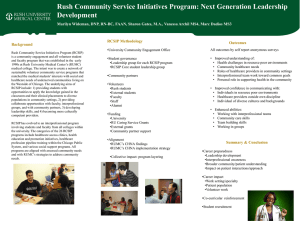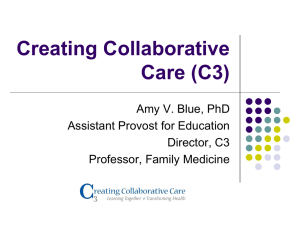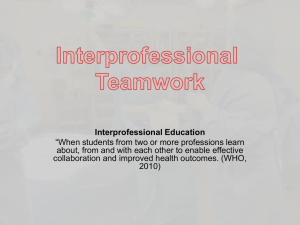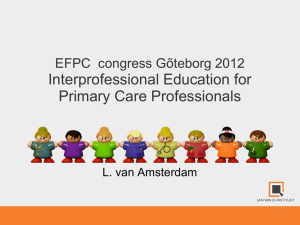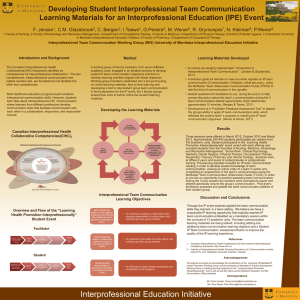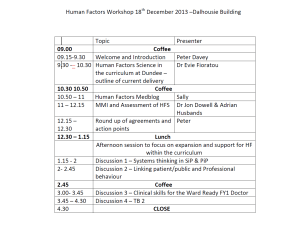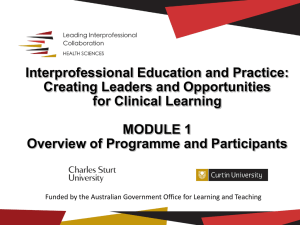Interprofessional Collaboration
advertisement
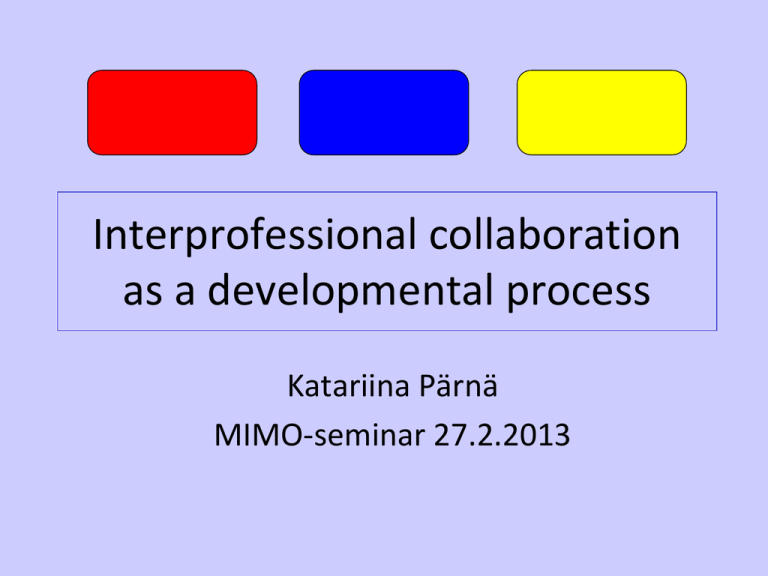
Interprofessional collaboration as a developmental process Katariina Pärnä MIMO-seminar 27.2.2013 Themes today • The Foundation for the Rehabilitation of Children and Young People (=>context to collaboration and context to ”Art-Based Methods in Well-Being” • Interprofessional Collaboration in the context of research • Models f interprofessional collaboration • Interprofessional collaboration as a developing process • The Foundation for the Rehabilitation of Children and Young People was established in 2000 by the Mannerheim League for Child Welfare. Both the League and the Foundation are non-profit-making, non-governmental organizations concerned with child welfare and child protection as expressed in the UN Convention on the Rights of Children and in the objectives of the Finnish Ministry of Social Affairs and Health. • The Foundation comprises the Huvitus Rehabilitation and Development Center at Yläne (in southwestern Finland, 65 kilometers north of Turku) • Huvitus began operations in the summer of 1994. • The Foundation serves about 700 families annually. WE WORK WITH • Families of the child welfare authorities (psycho-social family rehabilitation) • Families with children with disabilities (reorientation courses of families, rehabilitation and coping assessment periods for young people) • Families, children and young people for whom individual rehabilitation has been planned together with a hospital, local authority or an organization • Professionals who come to our Center for training COLLABORATING ORGANIZATIONS • The Finnish Slot Machine Association • The Social Insurance Institution • The Insurance Rehabilitation Agency • Local authorities throughout Finland OUR TOOLS • VIG® (video interaction guidance) • Theraplay® • Experiential methods – – – – – Adventure Outdoor activities Sports Music Arts and handicrafts • Training of everyday activities • Dialogical Network cooperation EXPERIENTIAL WORKING METHODS SUCH AS OUTDOOR ADVENTURE, ARTS AND MUSIC • Build relations between family members • Help restructure the family • Give children a place and a voice • Provide opportunities to practice relational and parenting skills • Bring family workers into contact with children and their world of experience • Build communication and cooperation between family and family workers ”Art-based Methods and Well-Being” Interprofessional Collaboration and research Research questions: • How locally cathered interprofessional teams build cooperative work culture and what contentual interpretations it receives? • How employees describe their collaboration, and what kind of tension and challenges there are? • What is it as a practice? • How to support the combining of employees´competence? • What kind of developmental process can be identified in the deepening collaboration? (Pärnä 2012) Research design and Data • The Research design has charasteristics of - action research - dewelopmental work research - case study research • Empirical data includes - interviews (7) - group discussions (10) from the meetings where employees evaluate the activities implemented during the project - documents produced during the project - work papers and official documents - field notes Theory & Analyse Theory • System of profssions and their linked ecologies (Abbott 1988, 2005) • Relational agency in expertice (Edwards 2009) • Conceptual analyses of interprofessional collaboration (D´Amour et. al. 2005, Leathard 2003, Gittling 1994) Analyse: - Qualitative content analysis - Also charasteristics of narrative interpretation - The analysis combines data-based and theorydirected interpretation Main Concepts • Profession • Boundary work, crossing of boundaries • Relational agency • Interprofessional Collaboration • Process • Preventive family work Why to collaborate • Today the multiple needs of children and their families are becoming more complex. • Interprofessional collaboration is usually considered to be related to challenging customer situations where issues such as the treatment of a customers disease, problems in life control or the mapping of learning difficulties require Efficient collaboration between professionals • The current political-administrative steering in social and health services also emphasises the role of interprofessional collaboration in preventive work, such as early intervention services for families • Professionals can learn from the other professionals and from customers • It is also possibility to put empowering point of view in the core of interprofessional collaboration. Interprofessional collaboration • It is very common, even popular, in planning and governing modern health and social services, as well all human services. • As a concept, interprofessional collaboration is widely used, in various documents it is usually mentioned as a form or method of collaboration • Typically it is not specifically defined, but instead its meaning is taken for granted and it is assumed to be implicitly understood • It’s also usually used in very positive meaning– thought is that interprofessional collaboration gives some extra and something good for the relationship between partners • There are also stories about barries and difficulties. Profession “ In the strictest sense of the term [profession], a high-status occupation composed of highly trained experts performing a very specialized role in society. A profession has exclusive possession of competence in certain types of knowledge and skills crucial to society and its individual clients. The special intensive education and necessary discipline develops a strong in-groups solidarity and exclusiveness. Every profession, on the basis of its monopoly of knowledge and skills and its responsibility for the honor and perpetuation of the profession, tends to feel that it is by itself capable of formulating its ethics and judging the quality of its work. Thus professional groups tend to reject the control of the public or clients they serve. Nevertheless, a profession is, of course, influenced by the public it professes to serve, and its shaped by the needs of other interest groups and by the demands of other professional organizations.” (A Modern Dictionary of Sociology, Theodorson et al. 1970) System of professions • Theory about Professions (Abbot 1988) ” How abstract is abstract enough to be professional” (Abbott 1988, 9) • Competition between professions • Jurisdiction (claims to classify the problem -> interference -> treatment) • Amalgamation < = > division • Boundary work Boundary work and crossing the boundaries • Boundary work are at the core of interprofessional collaboration • Professions have different ways to react; amalgamation or division (horisontal or vertical) (Abbott 1988) • Boundaries between professionals and boundaries between professionals and users (see Arnkil 1992) • Collaborative learnig: shared understanding and shared reality (Leinonen et al. 2006) • New teams/professionals need to mediate their collaboration at the boundaries, recognised the boundary space and boundary zones (Edwards 2010) Relational agency (Edwards 2010) • Relational agency of professional practice • Expertice is created as a result of the relations between professionals and between professionals and customers • Professions develop, create their practices and change in relation to one another - interactional expertice - contributory expertice ; interprofessional negotiation (interview -> discussion -> conversation) Interprofessional collaboration • The concept of interprofessional collaboration is often used as describing the method or approach of working (Isoherranen 2005, Morrow et al. 2005, Larivaara & Taanila 2004). • Interprofessional vs. intraprofessional collaboration • Inter (between), multi (many) • Lot of related concepts Interprofessional collaboration: Definitions ”The term ´interprofessional collaboration´ is the key term that refers to interaction between the professionals involved, albeit from different backrounds, but who have the same joint goals in working together.” (Leathard, 2003) ”The term collaboration conveys the idea of sharing and implies collective action oriented toward a common goal, in a spirit of harmony and trust.” (D´Amour et al. 2005) Five stage model of collaboration (Gitling et al. 1994) 1. Assesment and goal setting 2. Determination of a collaborative fit 3. Identification of resources and reflection 4. Project refinement and iImplementation 5. Evaluation and feedback Structuration model of interprofessional collaboration (D´Amour et al. 2005) 4. Governance -Managemenet - common practice 1. Finalization 3. Formalization 2. Interiorization Interprofessional Collaboration: Core of Concepts (D´Amour et al. 2005, rewiev) Concepts related to collaboration - type of relations - interaction between partners - sharing, partnership interdependency, power, process. Concepts related to team - Human context in which collaboration takes place - Collaboration within the teams can be described on the continuum of professional autonom -> different teams: - multi, - inter, - trans Different facets of sharing • • • • • • Shared responsibilities Shared decision-making Shared healt care philosophy Shared data Shared planning and intervention Shared professional perspectives Partnership • • • • • gollegial-like relationship Authentic and constructive Open and hones communication Mutual trust and respect Be aware of and value the contributions and perspectives of the other professionals • Partners pursue a set of common goals • Specific outcomes Interdependence • Mutual dependence • Collaboration requires that professionals be interdepent rather than autonomous • Interdependencu arises from a common desive to address the patients/ckients needs • Complexity oh health/social problems demands the expertice of each og the professionals on the toeam • Individual contributions are maximized / the outpu of the whole becomes much larger than the sum of inputs from each part • Collective action Power • Collaboration is seen as a true partnership characterized by the simultaneous empowerment of each participant • Power is based on knowledge and expertice (rather than on functions or titles) • Power is a product of the relationships and interactions between team members • In order to maintain actual and perceived symmetry in power relationships, collaborative interaction is required • Power cannot be separeted from the relationship througt wich it is exercised Process • • Collaboration is seen as a dynamic or transforming process the structure of collective act The collaboration process may follow very comcrete steps, such as negotiation and compromise in decision-making or shared planning and intervention • ”Professional boundaries be transcended if each of participants is to contribute to improvements in client care while duly considering the qualities and skills of the other professionals.” (D´Amour et al. 2005) Interprofessional collaboration: remember your own colour and mix it with other But in worsiest case, it looks odd But in best way it gives possibilities for clients and professionals Interprofessional collaboration as a process (Pärnä 2012) Requires of collaboration Identification of customeroriented cooperation need Trust and willingness to cooperation Crossing the professional boundaries Target-orientation and structurally leaded collaboration Plan together Effective interprofessional collaboration Do together Evaluate together Empowering clients and professionals Developing professional skills and organisational structures/cultures Refrences • • • • • • • • • • • • Abbott, A.(1988) The system of Professions. An essay on the Division of Expert Labor. The University of Chicago Press, London. Arnkil, E. (1992) Sosiaalityön rajasysteemit ja kehitysvyöhyke. Jyväskylä studeis in education, psychology and social research 85, Jyväskylän yliopiston monistuskeskus and Sisäsuomi Oy, Jyväskylä. D´Amour, D., Ferrada-Videla, M., Rodriguez, L. & Beaulieu, D. (2005) The conceptual basis for interprofessional collaboration: Core concepts and theoretical frameworks. Jounal of Interprofessional Care, vol 19 (S1): 116-131. Taylor & Francis Ltd. Edwards, A. (2010) Being an Expert Professional Practitioner. The relational Turn in Expertice. Springer, London. Gitling, L.N., Lyons, K. & Kolodner, E. (1994) A model to build collaborative research or educational teams of health professionals in gerontology. Educational Gerontology, vol 20, 15-34. Hall, P. (2005) Interprofesional teamwork: Professional cultures as barriers. Journal of Interprofesional Care, Vol 19, S1, 188-196. Taylor & Frances Ltd. Isoherranen, K. (2005) Moniammatillinen yhteistyö. Larivaara, P.& Taanila, A. (2004) Towards interprofessional family-oriented teamwork in primary sevices: the evaluation of an educational programme. Journal of Interprofessional Care, vol 18, pp. 153-163, Taylor & Francis Ltd. Leathard, A. (2003) Models for interprofessional collaboration. In Leathard, A. 8edit.) Interprofessional collaboration. From Policy to Practice in Health ans Social Care. Brunner & Routledge, New York, 3-119. Leinonen, P., Järvelä, S. & Häkkinen, P. (2006) Yhteisöllinen oppiminen ja tietoisuustyökalut hajautetun tiimityön kontekstissa. Teoksessa Toivainen, H. & Hänninen, H. (edit.) Rajanylitykset työssä. Yhteistoiminnan ja oppimisen uudet mahdollisuudet. PS-kustannus, helsinki. 138-162. Morrow,G., Malin, N. & Jennigs, T. (2005) Interprofessional team working for child and family referral in a Sure Start local programme. Journal of Interprfessional Care, vol. 19(2): 93-101. Taylor & Francis Ltd. Pärnä, K. (2012) Kehittävä moniammatillinen yhteistyö prosessina. Lapsiperheiden varhaisen tukemisen mahdollisuudet. Turun yliopisto. Turun yliopiston julkaisuja. Sarja C, osa 341. Scripta Lingua Fennica Edita. Uniprint Oy. Turku. Thank you ! • For further information, pleace contact by e-mail: katariina.parna@mll.fi • www.lastenkuntoutus.net Have a nice spring!

